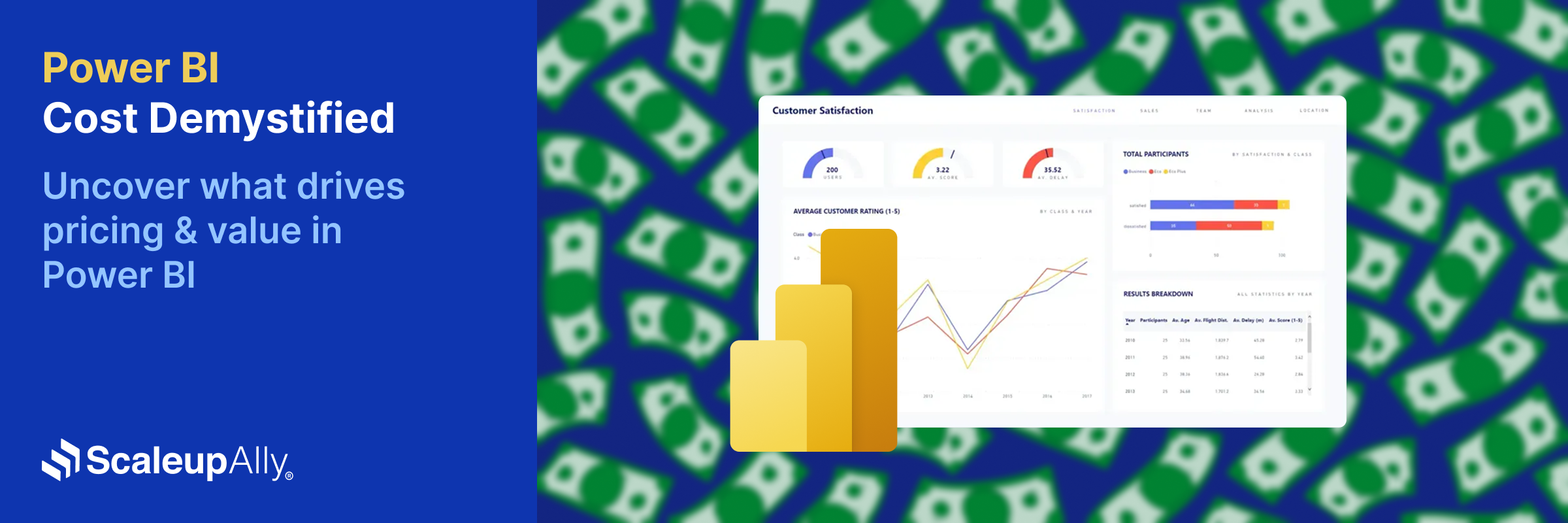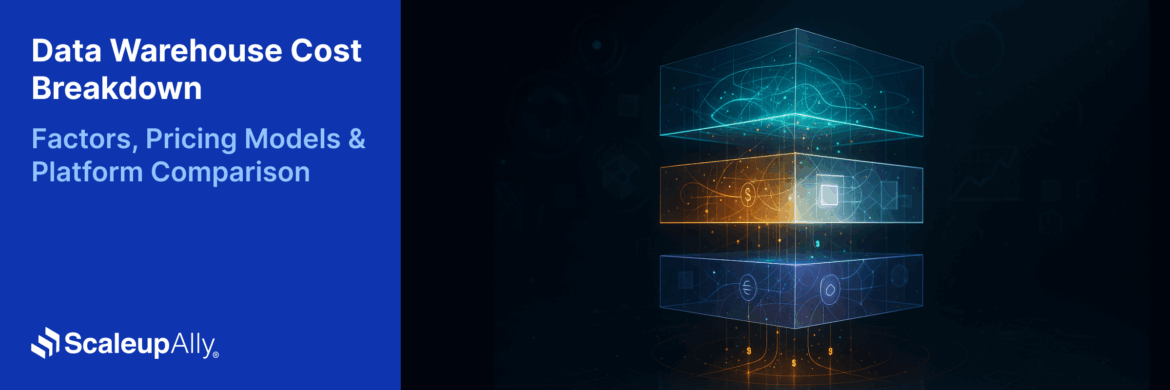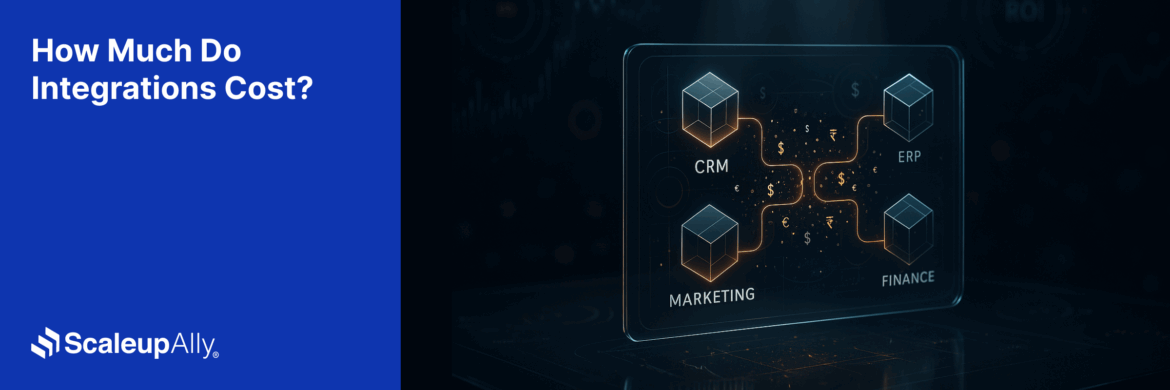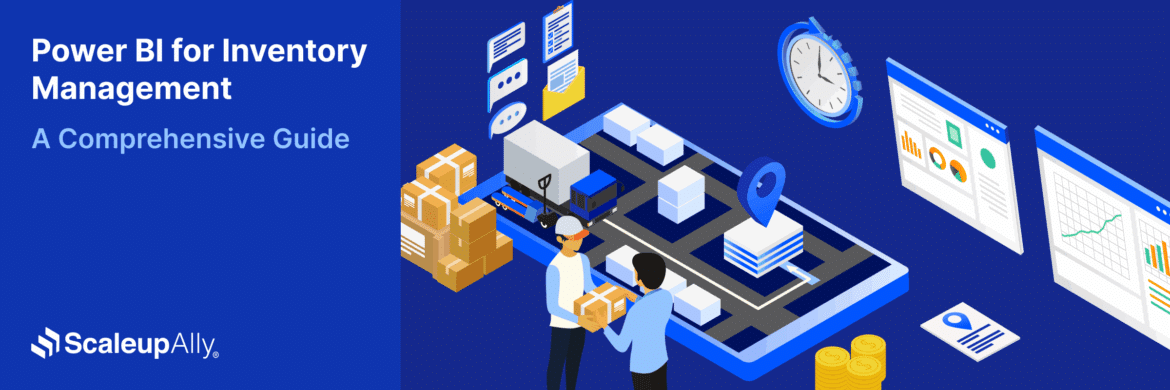
Power BI Cost: Comprehensive Guide to Pricing Plans
Tarsem Singh | June 30, 2025 , 12 min read
Table Of Content
Are you tired of jargon-filled explanations? This comprehensive guide offers a straightforward and easy-to-understand explanation of Power BI costs for the various pricing plans.
It will help you understand the features and costs associated with each plan so you can choose the best solution for your data analytics needs.
What is a Power BI License?
A Power BI license determines what features you can access, how much data you can store, and whether you can collaborate or share reports. Selecting the right license type is essential for scalability and cost-efficiency.
A Power BI license defines:
- Collaboration capabilities (individual vs team sharing)
- Data refresh and model size limits
- Access to advanced AI, governance, and security tools
- Cost per user or per capacity (monthly)
Understanding the Different Power BI License Types and Their Costs
Microsoft offers four licensing options for its Power BI users to maximize flexibility for businesses of all sizes and varying data needs.
Understanding the cost of Power BI for each type makes it easier to align your decision with your business goals and data consumption.
Let’s see what each license type offers.
1. Power BI Free/Desktop: Features and Cost
This is the entry-level of the Power BI licensing suite, and it costs $0. It enables users to connect data sources, analyse data, and create reports free of charge.
It is most suited for individual users or small local teams who need advanced data analytics and reporting without additional cost. It’s available for all Windows users to download and use.
While users can enjoy most of Power BI’s features, report sharing and collaboration are not allowed on this tier.
Features
- Create custom dashboards and reports with various visualisations, including charts and maps.
- Connect to data sources such as Excel, SQL databases, and cloud services (Azure, Salesforce).
- Use power query to perform data modelling, cleansing and transformations
- Create relationships between data sets.
- AI integrated for natural language queries.
- Perform advanced calculations using DAX functions to analyse your data.
- Design interactive reports and customise dashboards to present your data.
- You can save and publish reports locally on your desktop (reports are not shared online with others using this version).
- Export reports to formats like PDF or PowerPoint.
- Share reports manually via email or other platforms, but no direct sharing via the cloud.
- Storing data and reports in the dedicated workspace on the cloud within Power BI (in My Workspace – up to 1GB per user)
Cost:
- Completely free and available for Windows users (as of 2024)
2. Power BI Pro: Features and Cost
Power BI Pro is a paid monthly subscription that offers enhanced features beyond the free plan. Pro users can share and collaborate on reports, ensuring that each user accesses only relevant data.
For instance, headquarters can view all data, while regional teams see only their specific results.
Features
- Share reports and dashboards with other Power BI Pro users across your organisation.
- Allow team members to view, edit, and contribute to shared reports.
- Publish and access reports from anywhere via the internet or the Power BI mobile app.
- Embed reports in SharePoint, Teams, or other applications for wider organisational use.
- Create and participate in workspaces where teams collectively work on reports and dashboards.
- Have up-to-date information with the data refresh feature.
- Control who can access specific reports and data using row-level security.
- Set user permissions to protect sensitive data while providing different teams the necessary insights.
- Monitor real-time data from streaming sources for up-to-the-minute insights and decision-making.
- Create, distribute, and manage Power BI apps (packaged content like reports and dashboards) for wider organisational use.
Cost:
- US$14 per user/month (as of 2025).
- Requires a Power BI Pro license for each user who needs to create, share, or collaborate on reports and dashboards.
How Much Will Power BI Cost?
Estimate your organization’s total cost based on license type, team size, and usage.

3. Power BI Premium Per User: Features and Cost
Power BI Premium Per User (PPU) is an attempt to meet the needs of small teams or companies in advanced features typically found in the full Premium license, such as larger data models and expanded Dataflow functionality, without requiring the higher cost of a full Premium license.
Meaning, reports created under a PPU license can only be shared with others with a PPU license. Users with just a Pro license won’t be able to access them, which limits the audience.
This licensing type is not popular for this reason. Eventually, the need to share reports with a broader audience often arises, potentially doubling the cost of Power BI licensing for the organization.
Features
- Access to features typically reserved for enterprise-level Power BI Premium capacities, such as the ability to host reports in Power BI Service with greater scalability.
- Share reports with other users who also have a PPU license.
- Share larger datasets with premium performance and capacity.
- Supports larger data models (up to 100 GB per dataset) for handling complex and large-scale data analysis.
- 100 TB of storage capacity in the cloud for storing datasets and reports.
- Faster performance and higher refresh rates (up to 48 times per day).
- Access to AI-powered features, including AutoML (automated machine learning) and cognitive services, for more advanced data insights and predictive analytics.
- Ability to create, share, and export paginated reports, which are pixel-perfect and ideal for printing or creating detailed layouts.
- Use dataflows to ingest, transform, and manage data at scale, improving data quality and consistency across reports.
- BYOK (Bring Your Own Key) encryption and advanced governance features provide control over data security.
- Manage report development with deployment pipelines for promotion of reports and datasets from development to production environments.
Cost:
- US$24 per user/month (as of 2025).
- Requires a PPU license for each user who needs access to the premium features and reports.
4. Power BI Premium and Standard memberships
Companies can choose between two types of subscriptions: Standard and Premium. The Standard option requires a Power BI Pro license. With this subscription, users work within what is known as “shared capacity.”
A Power BI Pro license user can collaborate with other users of the same licensing type.
However, reports published in a shared capacity can only be shared with others with a Power BI Pro license.Non-Power BI Pro license users cannot view reports.
Power BI Standard (Pro)
Features:
- Share dashboards and reports with other Pro users within the organisation.
- Work in shared workspaces with team members to build and view reports.
- Schedule up to 8 data refreshes per day for real-time insights.
- Supports datasets up to 1 GB in size.
- Export reports to formats like Excel, PDF, and PowerPoint.
- Publish reports to the Power BI Service for web and mobile access.
- Integrate with Excel, Teams, and SharePoint for seamless collaboration.
- Restrict access to specific data within reports for different users.
Cost:
- US$10 per user per month (as of 2024).
Power BI Premium
Features:
- Includes all features of Power BI Pro.
- Supports datasets up to 100 GB.
- Create pixel-perfect reports for print or detailed layouts.
- Access advanced AI and machine learning tools, like AutoML and cognitive services.
- Schedule up to 48 refreshes per day for real-time data.
- Manage larger datasets and complex data flows at scale.
- Faster query processing and premium performance for larger datasets.
Cost:
- US$20 per user per month (as of 2024).
Microsoft Fabric Bundling: What It Means for Power BI Costs
With the introduction of Microsoft Fabric, Power BI is now part of a unified analytics platform that combines data engineering, data science, real-time analytics, and business intelligence into a single SaaS offering. This integration has significant implications for Power BI Premium users—especially in terms of value and cost-efficiency.
Previously, organizations had to manage separate tools and infrastructure for BI, data lakes, and ML workflows. Now, Power BI Premium capacity includes Microsoft Fabric features by default, allowing teams to streamline analytics operations under one roof.
Key Benefits of Microsoft Fabric Bundling with Power BI:
- Unified Capacity Management
Power BI shares capacity with other Fabric workloads (e.g., Synapse Data Engineering, Data Factory), allowing flexible allocation of compute and storage resources.
- Lower Total Cost of Ownership
Instead of paying separately for multiple analytics tools, teams can now operate under a single, consolidated Microsoft Fabric SKU—resulting in potentially lower overhead.
- Enhanced Collaboration Across Teams
Developers, data scientists, and business analysts can work within a shared environment, reducing friction between departments and speeding up insight generation.
- Seamless Data Integration
Leverage a single OneLake data foundation to integrate structured, semi-structured, and unstructured data without constant duplication across tools.
What This Means for You
If you’re considering Power BI Premium, you’re no longer investing in just a reporting solution—you’re gaining access to a broader analytics platform. This makes Premium capacity even more attractive for enterprises looking to scale beyond dashboards into real-time analytics, machine learning, and unified data operations.
Power BI Licensing Cost Comparison
Even though the purpose of the different Power BI licensing options provided by Microsoft is for versatility, the downside is that they can be confusing when buying.
The following table provides a side-by-side comparison of the Power BI cost to clarify this confusion and help you make a better choice.
| Feature | Free | Pro ($14/user) | Premium PPU ($24/user) | Premium Capacity ($4995/month) |
|---|---|---|---|---|
| Sharing & Collaboration | ❌ | ✅ Pro users only | ✅ PPU users only | ✅ Unlimited |
| Max Dataset Size | 1 GB | 1 GB | 100 GB | 400 GB |
| Refresh Frequency | 8/day | 8/day | 48/day | 48/day |
| Paginated Reports | ❌ | ❌ | ✅ | ✅ |
| AI/ML Features | Limited | Basic AI | Full AutoML & Cognitive | Full AutoML & Cognitive |
| Storage Limit | 1 GB | 10 GB/user | 100 TB total | 100 TB + Dedicated Nodes |
Also read: Power BI Consultant Hourly Rates
Which Power BI License Should You Choose?
Your choice of Power BI license depends on your data complexity, operational scale, pricing considerations, and business needs. Here are our recommendations:
For Small Businesses
A Power BI Pro subscription is ideal for small teams with limited data. At just $14 per month, it offers data sharing, collaboration, and reporting features—perfect for creating and sharing insights without advanced capabilities.
For Medium Businesses
Consider Power BI Premium Per User for medium-sized businesses needing advanced analytics and larger datasets. At $24 per month, it unlocks premium features like paginated reports and AI-driven insights, making it a great fit for teams seeking higher capacity without enterprise-level costs.
For Large Businesses
Power BI Premium (Capacity-Based) is best for large enterprises with extensive data needs and high-volume usage. This option allows unlimited sharing, supports massive datasets, and provides dedicated cloud resources, ensuring top-tier performance and full organizational control.
Also Read: Power BI Best Practices
Conclusion
The decision to have either Power BI Free, Pro, Premium, or both will depend on several factors, with the cost of Power BI being a key consideration for many organizations. For larger organisations with more users than developers, Power BI Premium is ideal.
As your self-service analytics needs grow, Premium offers the scalability and flexibility required, especially with the addition of Microsoft Fabric. Take the time to assess each tier available and determine the best fit for your business and its goals.
As an expert Power BI development company, ScaleupAlly is passionate about enabling organisations to develop, share, and utilise the full potential of Power BI.
We help organisations of all sizes build Power Platform solutions in weeks, enabling you to go from data to insights in as little time as possible.
To learn more about what the Microsoft Power Platform can do for you and how to plan your Power BI deployment, connect with us for a free consultation today.
Frequently Asked Questions
Q: How much does Power BI cost?
Power BI offers various pricing plans, starting with Power BI Free, which is free. Power BI Pro costs US$14 per user per month, and Power BI Premium starts at US$24 per user for PPU.
Q: What is the difference between Power BI Pro and Power BI Premium?
Power BI Pro is a per-user license that allows report sharing and collaboration. Power BI Premium offers additional features like higher storage, AI tools, and dedicated capacity, with per-user and enterprise-level licensing options.
Q: Is Power BI free for individuals?
Yes, Power BI Free is available for individuals. It allows users to create reports and dashboards but has limited sharing capabilities. For advanced sharing and collaboration, Power BI Pro or Premium is required.
Q: How much does Power BI cost for small businesses?
For small businesses, Power BI Pro costs $14 per user per month and is typically sufficient for most needs. If additional scalability or advanced features are required, you can choose Power BI Premium Per User, starting at US$24 per user per month.
References:
- Microsoft | Power BI Pricing: https://www.microsoft.com/en-us/power-platform/products/power-bi/pricing
Related Blogs

Data Warehouse Cost Breakdown: Factors, Pricing Models & Platform Comparison
Discover how much a data warehouse costs in 2025. Explore pricing models, key factors, and platform comparisons to plan your data budget effectively.
Tarsem Singh
Nov 6 ,
14 min read

How Much Do Integrations Cost? [Pricing Breakdown & Key Insights]
Learn how much integrations cost, key factors influencing pricing, hidden expenses to avoid, and effective ways to reduce integration costs.
Tarsem Singh
Nov 6 ,
9 min read

Power BI for Inventory Management: A Comprehensive Guide
Explore the hidden power of Power BI for inventory management and how it provides businesses with powerful analytics and visualization capabilities.
Tarsem Singh
Oct 8 ,
19 min read


